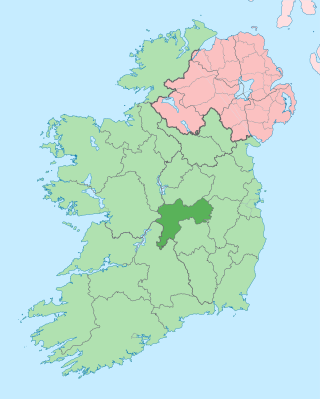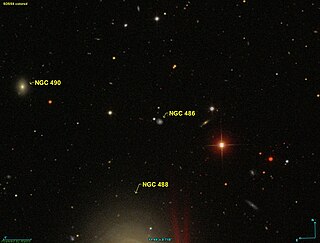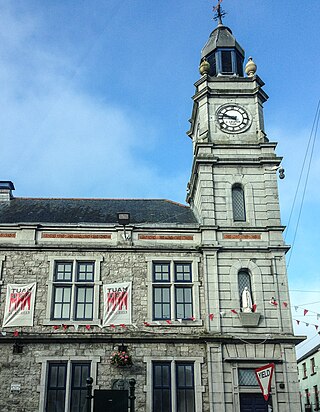
County Offaly is a county in Ireland. It is part of the Eastern and Midland Region and the province of Leinster. It is named after the ancient Kingdom of Uí Failghe. It was formerly known as King's County, in honour of Philip II of Spain. Offaly County Council is the local authority for the county. The county population was 82,668 at the 2022 census.

Sir Charles Algernon Parsons was an Anglo-Irish marine engineer best known for his invention of the compound steam turbine, and as the eponym of C. A. Parsons and Company. He worked as an engineer on dynamo and turbine design, and power generation, with great influence on the naval and electrical engineering fields. He also developed optical equipment for searchlights and telescopes.

Birr is a town in County Offaly, Ireland. Between 1620 and 1899 it was called Parsonstown, after the Parsons family who were local landowners and hereditary Earls of Rosse. The town is in a civil parish of the same name.

Earl of Rosse is a title that has been created twice in the Peerage of Ireland, both times for the Parsons family. "Rosse" refers to New Ross in County Wexford.

William Parsons, 3rd Earl of Rosse, was an English engineer and astronomer. He built several giant telescopes. His 72-inch telescope, built in 1845 and colloquially known as the "Leviathan of Parsonstown", was the world's largest telescope, in terms of aperture size, until the early 20th century. From April 1807 until February 1841, he was styled as Baron Oxmantown.

Birr Castle is a large castle in the town of Birr in County Offaly, Ireland. It is the home of the 7th Earl of Rosse and his family, and as the castle is generally not open to the public, though the grounds and gardens of the demesne are publicly accessible, and include a science museum and a café, a reflecting telescope which was the largest in the world for decades and a modern radio telescope.

Mary Ward was an Irish naturalist, astronomer, microscopist, author, and artist. She was killed when she fell under the wheels of an experimental steam car built by her cousins. As the event occurred in 1869, she is the first person known to have been killed by a motor vehicle.
William Clere Leonard Brendan Parsons, 7th Earl of RosseHonFTCD, is an Anglo-Irish peer. He is also 10th Baronet Parsons, of Birr Castle.

William Edward Parsons, 5th Earl of Rosse was an Irish peer and British Army officer. He was known as Lord Oxmantown until 1908.

Lawrence Parsons, 2nd Earl of Rosse, known as Sir Lawrence Parsons, Bt, from 1791 to 1807, was an Irish peer.
Sir William Parsons, 4th Baronet of Birr Castle was an Irish politician and baronet.

Mary Parsons, Countess of Rosse, was an Anglo-Irish amateur astronomer, architect, furniture designer, and pioneering photographer. Often known simply as Mary Rosse, she was one of the early practitioners of making photographs from waxed-paper negatives.
Lawrence Harman Parsons, 1st Earl of Rosse, known as The Lord Oxmantown between 1792 and 1795 and as The Viscount Oxmantown between 1795 and 1806, was an Anglo-Irish peer and politician.

NGC 486, also occasionally referred to as LEDA 1281966 or GC 275, is a spiral galaxy in the constellation Pisces. NGC 486 was discovered on December 6, 1850 by Irish engineer Bindon Blood Stoney.

NGC 501, also occasionally referred to as PGC 5082 or GC 284, is an elliptical galaxy in the constellation Pisces. It is located approximately 224 million light-years from the Solar System and was discovered on 28 October 1856 by Irish astronomer R. J. Mitchell.
Sir Lawrence Parsons was an English-born barrister, judge and politician in seventeenth-century Ireland, who enjoyed a highly successful career, despite frequent accusations of corruption and neglect of official duty. His success owed much to the patronage of his uncle Sir Geoffrey Fenton, of his cousin by marriage Richard Boyle, 1st Earl of Cork, and of the prime Royal favourite, the Duke of Buckingham. He was the ancestor of the Earl of Rosse of the second creation. He rebuilt Birr Castle, which is still the Parsons family home.

Dundalk Town Hall, is a municipal building in Crowe Street, Dundalk, County Louth, Ireland. It currently accommodates the An Táin Arts Centre.

Tullamore Town Hall, is a municipal building in Cormac Street, Tullamore, County Offaly, Ireland. The building currently accommodates the local offices of Offaly County Council.

Tuam Town Hall is a municipal building in the Market Square at Tuam, County Galway, Ireland. It is currently used as a community events venue.

Gloster House is a Georgian-Palladian country house operating as a hotel and wedding venue near Brosna, County Offaly, Ireland. The design of the house has sometimes been attributed to the architect Edward Lovett Pearce who was a cousin of the owner, Trevor Lloyd, at the time the main house was constructed around 1720 – although no firm evidence of this survives.















